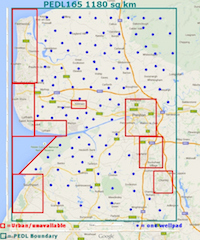Weil Bodies
A week or so ago number of Protectors were on the roadside by Wensley’s farm and noticed that a cow, which seemed to have been isolated in the field next to his house, had a very red udder.
Today, while at Preston New Road I went to inspect Cuadrilla’s new protest pen. It’s in the area covered by an injunction granted to 12 claimants, who include two Cuadrilla companies and 10 other interested parties, so the fact that Cuadrilla have claimed that just one of those parties, Mr Wensley, claim that they grant limited permission for access doesn’t really change a thing. Access would still clearly be in breach of the injunction granted in Manchester by HH Judge Raynor
Anyway, for obvious reasons I didn’t go in, but I did read the notice pinned to the fence outside the protest pen. Here it is.

Note the highlighted section which reads:
An anti-bacterial station is positioned at (sic) the area and users of the area are advised to use that station when entering and exiting the area. Please observe the signs in the area regarding leptosporosis
Now, I am familiar with leptosporosis because it is also known as Weil’s Disease, and as a water-sports enthusiast I have to be careful of rat infested water as rat’s urine is a common vector for this nasty disease.
NHS Choices tells us
Leptospirosis is a type of bacterial infection spread by animals. It’s caused by a strain of bacteria called leptospira.
In 90% of cases, leptospirosis only causes mild flu-like symptoms, such as a headache, chills and muscle pain.
However, in some cases the infection is more severe and can cause life-threatening problems, including organ failure and internal bleeding. In its most severe form, leptospirosis is also known as Weil’s disease.
The common mild symptoms mean most leptospirosis infections are hard to diagnose. Diagnosis is easier if the infection causes more serious problems.
…
Leptospirosis is spread to humans by animals.
You can catch it by touching soil or water contaminated with the urine of wild animals infected with the leptospira bacteria.
Animals known to be carriers of the leptospira bacteria include cattle, pigs, dogs and rodents, particularly rats.
I hadn’t been aware that cattle could be carriers, although I have noticed that there is no shortage of rats in Cuadrilla’s working area 😉
In cattle “a peculiar type of mastitis is another distinctive form of leptospirosis.” . I am no vet and it may, of course, be coincidental that one of Mr Wensley’s cattle appeared to have an inflamed udder. If he let’s us know we’ll update this.
Either way it seems very strange that Cuadrilla are inviting people to stand in an area where they clearly believe there is a risk of contracting a potentially fatal disease. The risk is presumably fairly small (there are only 40 cases a year reported in humans in the UK) but the requirement for plastic bottles of hand sanitiser is hardly reassuring. Let’s hope none of the hordes who throng to view the PNR flaring is wearing sandals and there isn’t a footbath!

Perhaps they should not be too surprised to learn that nobody I know was intending to enter the area even before they announced it was a potential source of leptosporosis. However, it does bring into question the fact that vehicles are constantly being allowed to leave the site without the wheel washing, and there is no sign of similar bottles of hand sanitiser at the site entrance /exit. Why not?
We are really not sure what is going on here but if Farmer Wensley or Cuadrilla’s PR consultants on the “Community Information Line” would like to clarify things we will happily include their comments here.


































